Samsung Galaxy Camera vs Galaxy S3: Camera comparison
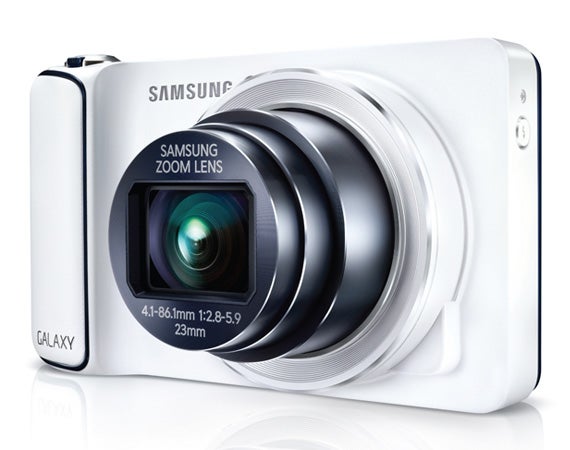
The Samsung Galaxy Camera is the most advanced Android camera we’ve ever seen. It offers a huge optical zoom, 16MP sensor and all the goodies of Android. But does it marry the best bits of Android and a proper camera, or is it a camera that no-one should really buy?
To see if its camera is really all that much better than a standard top-end smartphone, we took the Samsung Galaxy Camera and Samsung Galaxy S3 out for a photographic spin to see how their pictures compare.
Specs
Samsung Galaxy Camera – 16.3MP, Xenon flash, 1/2.3″ sensor, f/2.8-5.9 aperture, 23-482mm focal length
Samsung Galaxy S3 – 8MP, LED flash, 1/3.2″ sensor, f/2.6 aperture,16mm equivlent focal length
In specs terms, the Samsung Galaxy Camera and Galaxy S3 have very little in common. One has an LED flash, the other a “proper” Xenon. The Galaxy Camera’s sensor also offers twice the resolution of the S3’s 8-megapixel model, and the sensor itself is significantly larger.
However, we shouldn’t forget that the Samsung Galaxy Camera’s sensor is still firmly in compact camera territory. Compact system cameras like the Sony NEX-5n and Olympus E-PL3 offer much, much larger sensors still.
The Samsung Galaxy S3 offers the same sensor size as most top-end cameras, the only real abberation in this field being the Nokia Lumia 920 with its 1/3″ chip, or the much larger 1/1.2″ chip of the virtually stillborn Nokia 808 Pureview.
Basic Picture Comparison

Samsung Galaxy S3 – London skyline
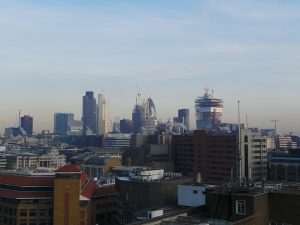
Samsung Galaxy Camera – London skyline
The first thing you may notice about these two basic shots is how differently they frame this scene. The Galaxy Camera appears much more “zoomed in” because the wider focal length of the Galaxy S3 gives the phone a much wider field of view.
When the Samsung Galaxy Camera offers an otherwise versatile zoom lens, you might be surprised to find that the Galaxy S3 can produce shots the Galaxy Camera simply can’t.
Both shots are well-exposed, but the Samsung Galaxy Camera offers a slightly warmer tone that brings out the complexity of colour in the sky, and the highlights of buildings more successfully.
Detail Comparison
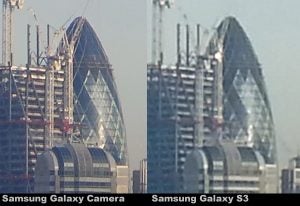
Zooming further into the above shots, the difference between the two cameras becomes much more obvious. The Galaxy Camera is able to resolve a much greater level of detail. This is in part down to the different focal length, the higher-resolution of the Samsung Galaxy Camera’s sensor and its much larger sensor size.
This crop also emphasises the poorer colour reproduction of the Galaxy S3. Its rendition of these buildings is far cooler, without the auburn colouring of the Galaxy Cameras.
Digital Zoom vs Optical Zoom
Samsung Galaxy Camera – 21x optical zoom, 23-482mm focal length
Samsung Galaxy S3 – 4x digital zoom, 16mm focal length
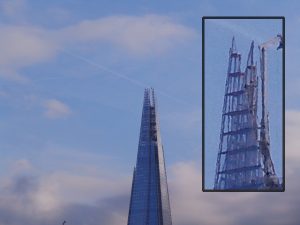
Here’s a shot of the Shard taken with the Samsung Galaxy Camera, at 5x optical zoom – far from the extreme end of the camera’s capabilities. This crop shows that some noise has been introduced, and there is some chromatic abberation around the fine detailing of the top of the structure.
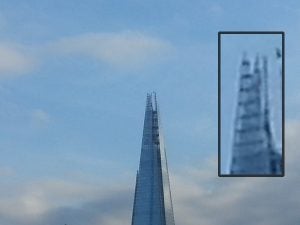
The Samsung Galaxy S3’s digital zoom fares much, much worse. In the non-zoomed part of the shot, noise in the well-lit sky is clearly visible – and this is “only” at 4x zoom.
Looking at the fine detail crop, you can easily see why we’d never recommend relying on a digital zoom. The top of the Shard has been reduced to an indistinct smudge.


